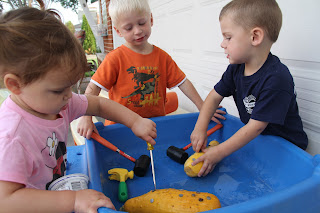We had the good fortune of receiving a really cool stone collection compliments of Joselyn a few weeks back and the kids have been having a blast with it. Many of the rocks are heavy so I put them in the sensory table outside to see what the kids would make of them. I purposefully left the stone collection out without giving the children any directions or restrictions on the project, I wanted to see how the children would interact with this material that is traditionally taboo.
I was delighted to see that they were generally good at handling the rocks; they didn’t taste them or throw them at each other, when the kids did experiment by tossing rocks up in the air, we talked about the dangers of tossing rocks and they stopped.
The children are pretty creative and they have come up with a variety of uses for the rocks. So far they have been used for groceries, fast food and animal food in pretend play. (Perhaps we need a morning snack?!?) The children have used a lot of muscle power carrying, dumping, sorting or transporting rocks in the carts. They have also tried stuffing them in various containers, experimenting with size of the openings, weight and volume of containers. They figured out which rocks fit into the containers and how many rocks are too many to carry. They have spent hours trying to break rocks, transporting them from one end of the yard to the other and covering them in water to observe the color change as get all shiny and wet. They have been very, very busy!
I’m not sure if the fascination with rocks is due to the fact that rocks are usually off limits at home, that fact that they are cool because they were a gift from Joselyn or just because rocks are fun to play with. Whatever it is they are really having a lot of fun!
In all of our experimentation with rocks we noticed that many of the rocks are white or varied shades of grey and that the colors of the rocks became more contrasty once they got wet. I got to thinking of how we could bring our love of rocks indoors to the art area to further investigate contrast and monochromatic color schemes. 

We worked with black and white stones on black and white paper.
Some of the children sorted, scooped or counted stones, others filled containers or looked closely at the colors.
Later we used white paint on white paper or white paint on black paper then compared the outcomes.
In our final project we used black paint on black paper and black paint on white paper to illustrate contrast and monochromatic color schemes.
Some observations the children have made include:
Sam - the white ones are brighter and the black ones are darker - he also covered every square inch of 3 sheets of black paper in black paint
Logan - Lined up the black stones on black paper then counted 11 stones, he also scooped stones in heaps on paper
Carmen - Tried both the wide and narrow brushes in her paint, later she sorted them into the correct cups.
Will - Coverd his arms in black paint and says “It’s shiny!” He also piled stones up on the lazy susan and spun them off
Addie - Painted with white paint on white paper looked closely at the paper to see if she could see the paint.
Yoli - Correctly identified black and white then chose materials to explore paint. She also scooped stones into sectioned containers .
Once our paint was dry, we talked about how the white paint was difficult to see on white paper and the black paint was shiny while it was wet. Then I created a pattern from the artwork so the children could compare the similarities and differences of our color experimentation.






















































